
|
Regular Meetings Covid Era Annual Meeting and Volunteer Recognition Thursday, November 18, 2021 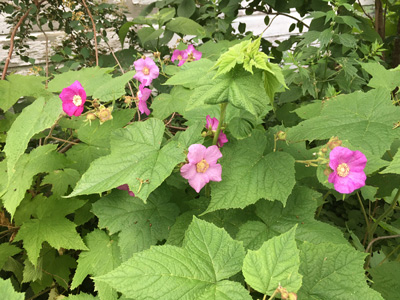
Wild Ones members are invited to attend our second virtual annual meeting on November 18th. This is our last meeting of the year and will include a state-of-the-chapter wrap-up and brief reports from board members and coordinators. We will also recognize our members who volunteered in chapter activities this past year. The meeting will end with a virtual tour of how our members are using native plants in their yards and other locations. Information on how to connect to the Zoom presentation will be posted on the Chapter website (www.wildonesrrvc.org) and Facebook page, and distributed via email to members prior to the meeting. The program is free and open to the public. For more information call (779) 537-8939.
Rubus odoratus (Purple-flowering Raspberry)
Our Meetings Conservation Planning in the Raccoon Creek Watershed
Kerry Leigh has worked in restoration ecology for much of her career and has an MA in Landscape Architecture. Her passion is protecting and restoring the natural communities of northern Illinois including working with rare and globally impaired ecosystems. She has also worked regionally doing watershed planning, facility planning area and wastewater treatment reviews for the IEPA, and Great Lakes restoration work with other regional planning agencies and local governments. Kerry became the Executive Director at NLI in 2013. She has served as a Vital Lands Illinois network architect for that statewide collaboration and is now on the board of the Prairie State Conservation Coalition and was appointed by the Governor of Illinois to the IDNR Advisory Board. Kerry is passionately committed to creative and enhanced partnerships and collaborative work approaches for impactful land protection for healthy soil, water, and air, and for effective stewardship. She has seen amazing results from those collaborations. Kerry grew up in DeKalb in her early years and has lived in over 30 residences, seven countries, and two US states. Kerry attended six different high schools in four years and completed all her higher education in Great Britain where she raised her family for many years before returning to Illinois in 1990. Information on how to connect to the Zoom presentation will be posted on the Chapter website (www.wildonesrrvc.org) and Facebook page, and distributed via email to members prior to the meeting. The program is free and open to the public. For more information call (779) 537-8939.
Sarah is the Community Engagement Specialist with The Land Conservancy of McHenry County. She has spent 20 years working in the environmental arena as an educator. Sarah has a personal and professional interest in sharing the functionality and joy that comes with incorporating native plants into any property. She has had the opportunity to visit and certify over 200 properties as part of The Land Conservancy’s Conservation@Home program and advises landowners on how to care for their land. Information on how to connect to the Zoom presentation will be posted on the Chapter website (www.wildonesrrvc.org) and Facebook page, and distributed via email to members prior to the meeting. The program is free and open to the public. For more information call (779) 537-8939.
Identification and Control of Invasive Species
The 1,240-acre University of Wisconsin Arboretum is a unique collection of remnant and restored prairies, oak savannas, woodlands, and wetlands located in the heart of Madison. Arboretum staff are also responsible for overseeing eleven outlying properties, seven of which are designated State Natural Areas, comprising another 500 acres. Michael also assists with research, outreach, and a variety of other tasks carried out by the Arboretum team. His career in conservation has spanned 20 years across several states and one Canadian province, with a primary focus on prairie ecology and restoration. He has a B.S. in Natural Resource Management from The Ball State University and an M.S. in Plant Biology from Southern Illinois University-Carbondale. Using Native Plants for Wildlife Habitat
Ken will take us on a virtual tour of the CRP plantings and discuss the advantages of using native species to create wildlife habitat. Information on how to connect to the Zoom presentation will be posted on the Chapter website (www.wildonesrrvc.org) and Facebook page, and distributed via email to members prior to the meeting. The program is free and open to the public. For more information call (779) 537-8939.
Wild Garden’s Frequent Fliers: Dragonflies and Damselflies
Cindy Crosby is the author, compiler or contributor to more than 20 books. Her most recent book is “Chasing Dragonflies: A Natural, Cultural, and Personal History” (Northwestern University Press, 2020). Her recent full-color book of photographs and essays is “Tallgrass Conversations: In Search of the Prairie Spirit” with co-author Thomas Dean (2019). She is also the author of “The Tallgrass Prairie: An Introduction” (Northwestern University Press, 2017). Cindy earned her master’s degree in natural resources from the University of Wisconsin-Stevens Point. She is a Master Gardener, a steward for the Schulenberg Prairie at The Morton Arboretum and at Nachusa Grasslands, a Nature Conservancy site with bison in Franklin Grove, IL. When she's not out working in her garden, she speaks and teaches on natural history topics in the Chicago region. Cindy blogs each week at Tuesdays in the Tallgrass, and you can find her classes and events at www.cindycrosby.com
Thursday, May 20, 2021 educational program The Rare Flora of Apple River Canyon The Natural Land Institute acquired the 149-acre Townsend Glade property in 2018 and designated it as an addition to the Apple River Canyon Land & Water Reserve in September 2020. The rare flora and unusual cliff communities of the Apple River Canyon in eastern Jo Daviess County have been recognized for more than 100 years. It’s unique geology and high-quality natural communities support 13 species of rare and endangered plants, including the only known population of Bird’s-eye primrose in Illinois. The Townsend Glade property has wet and dry dolomite cliffs that support the state-endangered white camass (Zigadenus elegans) and two state-threatened species, cliff goldenrod (Solidago sciaphila) and Sullivantia (Sullivantia sullivantia). Stands of native white pines and Canada yew grow on the bluffs along the canyon. Randy Nyboer has an MS degree in Botany from Eastern Illinois University. He worked on the Illinois Natural Areas Inventory in Southwestern Illinois and then served as District Natural Heritage Biologist in northwestern Illinois from 1978-1990 and Regional Administrator for the Division of Natural Heritage from 1990-2002. He was an Environmental Consultant and Endangered Species Program Manager for the Illinois Natural History Survey from 2002-2007 and worked on the update of the Illinois Natural Areas Inventory from 2008-2013. Starting in 2014 he led the terrestrial ecology team to evaluate the natural quality of the natural communities in the 60,000 acres of the Forest Preserves of Cook County to guide management and restoration of the land. Randy lives with his wife in Morrison, Illinois.
Thursday, April 15, 2021 educational program The Sedges You Know, the Sedges You Don’t Andrew Hipp conducts research on the origins and implications of plant biodiversity. His current work focuses on oaks, sedges, woody plant diversity, and interactions between diversity of plant lineages and biodiversity of plant communities. You can read about his research at http://systematics.mortonarb.org/ and follow his natural history blog (which includes plenty of sedges) at http://botanistsfieldnotes.com/. Thursday, March 18, 2021 educational program Woodpeckers of Illinois
Peggy is an Educator for University of Illinois Extension specializing in environmental education as it relates to wildlife and water quality issues. She holds a B.S. in Zoology with a specialization in wildlife management in which she is interested in human reactions and relationships to wildlife. She also holds an M.S. in Education with a specialization in Outdoor Teacher Education/Curriculum and Instruction. Peggy has been teaching environmental education for over 20 years, helping people understand wildlife as it relates to their lives. Thursday, February 18, 2021 educational program Ethnobotany and Natural History of Early Boone County, Illinois
Pam will use a worksheet that will be send to members when they are invited to the program. Pam Stock is a graduate of Judson College in Elgin and has a bachelor’s degree in Psychology. She worked in local school districts with special needs students, was the Outdoor Education Director at Lutheran Outdoor Ministries Center in Oregon, IL and retired from the Boone County Conservation District as the Special Events and Public Outreach Manager. She spent years in self-study in the fields of ethnobotany and folk medicine and is a Master Gardener Intern with the U of IL Extension Services. A Natural History of Boone County, Illinois. Presenter Josh Sage
Josh has worked for the Boone County Conservation District since 2001. He is a graduate of Western Illinois University and has been studying or participating in natural areas management since the late 1990’s. He resides in Boone County on an old farmstead where he enjoys tinkering, growing vegetables, and converting portions of his property to natives. He spends this time of year drinking coffee, staring at maps, and daydreaming about being in the backcountry, above tree line. Thursday, January 21, 2021 educational program Ghost Trees and The Missing Evolutionary Partners of Today's Osage Orange and Other Native Tree Species Osage Orange or what some call Hedge Apple, Maclura pomifera, is a common tree of old hedgerows and field edges throughout Northern Illinois. It’s wood had many uses by early settlers, it was widely planted to form thorny hedges to keep livestock enclosed before the advent of barbed wire, and the softball size bright green fruit is often sold for holiday decorations. But this native species has lost the animals that it evolved with, that ate the fruit and spread its seeds, making it one of several trees that are “Ghosts of Evolution.” These includes Paw Paw, Honey Locust, and Kentucky Coffeetree. Few animals that now exist eat the fruit, pods and seeds from these trees, leaving it to Native Americans and settlers to spread the plants to new habitats. If you have any questions, contact Jerry Paulson at paulsonjerry@aol.com or (815) 222.4414.
2021 Event Schedule - click here to download PDF January 21
February 18
March 18
April 15
May 20
June 17
July 15
August 19
September 16
October 21
November 21
December - No meeting, Happy Holidays.
|
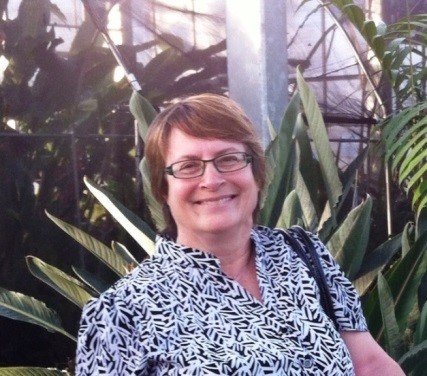 Creating a conservation plan for the Illinois portion of the Raccoon Creek Watershed is an important first step in protecting and conserving high quality land and habitat, and improving water quality in this cool water, relatively high quality stream. Clean water and land conservation also have positive impacts on the local economy, property values, and recreational opportunities. Moreover, it preserves the local heritage for future generations. Natural Land Institute (NLI) chose this priority area for protection because of the Nygren Wetland Preserve, which sits at the bottom of the watershed, and the threats facing this area. Learn about the goals and strategies, and where the climate-resilient areas are located.
Creating a conservation plan for the Illinois portion of the Raccoon Creek Watershed is an important first step in protecting and conserving high quality land and habitat, and improving water quality in this cool water, relatively high quality stream. Clean water and land conservation also have positive impacts on the local economy, property values, and recreational opportunities. Moreover, it preserves the local heritage for future generations. Natural Land Institute (NLI) chose this priority area for protection because of the Nygren Wetland Preserve, which sits at the bottom of the watershed, and the threats facing this area. Learn about the goals and strategies, and where the climate-resilient areas are located.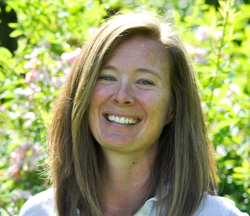 Sarah Michehl will present how our native oaks are woven into the fabric of our home landscape. The presentation will cover the reasons for their ecological importance and how to help the oak ecosystem as a whole.
Sarah Michehl will present how our native oaks are woven into the fabric of our home landscape. The presentation will cover the reasons for their ecological importance and how to help the oak ecosystem as a whole.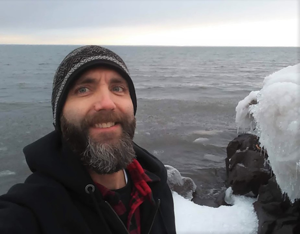 >Michael Hansen is the Land Care Manager at the UW-Madison Arboretum where he oversees field work including invasive species management and the prescribed fire program. Michael will provide an overview of the Arboretum's invasive species management program, including common invasive species and identification, strategies and methods for management at different scales, and challenges faced when working within an urban landscape.
>Michael Hansen is the Land Care Manager at the UW-Madison Arboretum where he oversees field work including invasive species management and the prescribed fire program. Michael will provide an overview of the Arboretum's invasive species management program, including common invasive species and identification, strategies and methods for management at different scales, and challenges faced when working within an urban landscape. 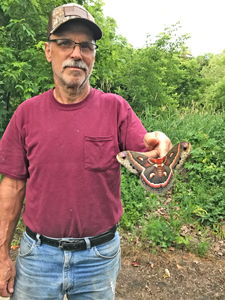 Ken Kielsmeier lives near Oregon, Illinois and has worked on a farm near Leaf River to plant native species to create habitat for birds and other wildlife. He used the U. S. Department of Agriculture’s Conservation Reserve Program (CRP) to covert about nine acres of cropland to tallgrass prairie and plant native trees and shrubs on another five acres. The CRP helps farmers convert marginal cropland to wildlife habitat by providing annual rental payments to the landowner. He planted the first CRP field in 2003, adding more land over the years.
Ken Kielsmeier lives near Oregon, Illinois and has worked on a farm near Leaf River to plant native species to create habitat for birds and other wildlife. He used the U. S. Department of Agriculture’s Conservation Reserve Program (CRP) to covert about nine acres of cropland to tallgrass prairie and plant native trees and shrubs on another five acres. The CRP helps farmers convert marginal cropland to wildlife habitat by providing annual rental payments to the landowner. He planted the first CRP field in 2003, adding more land over the years. Our June program will see the return of Cindy Crosby. Cindy is a dynamic speaker who has previously brought us programs on the tallgrass prairie and uses of native plants. This month we will discover the fascinating and bizarre lives of Dragonflies and Damselflies with plenty of group fun and lively interaction during the Zoom presentation. From their unusual life cycle of transformation, to their bizarre sex life, mystifying migratory habits, and their struggle for survival, there is plenty to discover and marvel about! Learn about their cultural history, including some of the myths and superstitions that surround them. Be amazed at their natural history as you see close-up beautiful photography of some of our dragonflies in Illinois. Find out how dragonflies tell us something about the health of our waterways --- and our world. Then discover how you can do simple things in your garden to attract these remarkable flying creatures.
Our June program will see the return of Cindy Crosby. Cindy is a dynamic speaker who has previously brought us programs on the tallgrass prairie and uses of native plants. This month we will discover the fascinating and bizarre lives of Dragonflies and Damselflies with plenty of group fun and lively interaction during the Zoom presentation. From their unusual life cycle of transformation, to their bizarre sex life, mystifying migratory habits, and their struggle for survival, there is plenty to discover and marvel about! Learn about their cultural history, including some of the myths and superstitions that surround them. Be amazed at their natural history as you see close-up beautiful photography of some of our dragonflies in Illinois. Find out how dragonflies tell us something about the health of our waterways --- and our world. Then discover how you can do simple things in your garden to attract these remarkable flying creatures.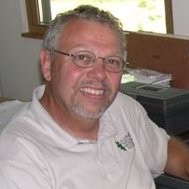 Randy Nyboer, former District Natural Heritage Biologist for the Illinois Department of Natural Resources and Endangered Species Program Manager for the Illinois Natural History Survey, will lead a virtual tour of the rare flora of Apple River Canyon and the new Townsend Glade Land & Water Reserve. The video will be presented during a live Zoom meeting and will be posted on our website to watch after May 20.
Randy Nyboer, former District Natural Heritage Biologist for the Illinois Department of Natural Resources and Endangered Species Program Manager for the Illinois Natural History Survey, will lead a virtual tour of the rare flora of Apple River Canyon and the new Townsend Glade Land & Water Reserve. The video will be presented during a live Zoom meeting and will be posted on our website to watch after May 20. 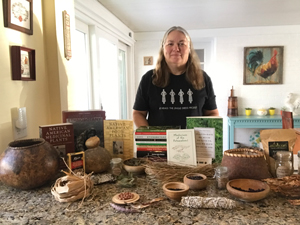 Pam Stock and Josh Sage, both with the Boone County Conservation District, will show two videos and then stick around for a discussion on Zoom. Each video is approximately 10 minutes long:
Pam Stock and Josh Sage, both with the Boone County Conservation District, will show two videos and then stick around for a discussion on Zoom. Each video is approximately 10 minutes long: 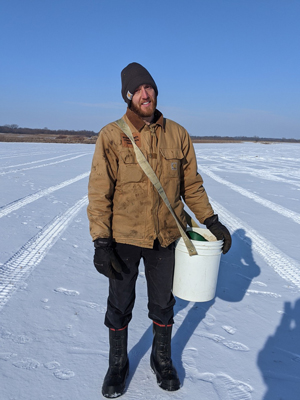 Josh Sage, the Director of Natural Resources at the Boone County Conservation District will discuss what Boone County looked like before European settlement and what events transpired that changed the landscape forever. He will also discuss the habitats that existed in Boone county before settlement, as well as the habitat types the Boone County Conservation District manages today.
Josh Sage, the Director of Natural Resources at the Boone County Conservation District will discuss what Boone County looked like before European settlement and what events transpired that changed the landscape forever. He will also discuss the habitats that existed in Boone county before settlement, as well as the habitat types the Boone County Conservation District manages today.